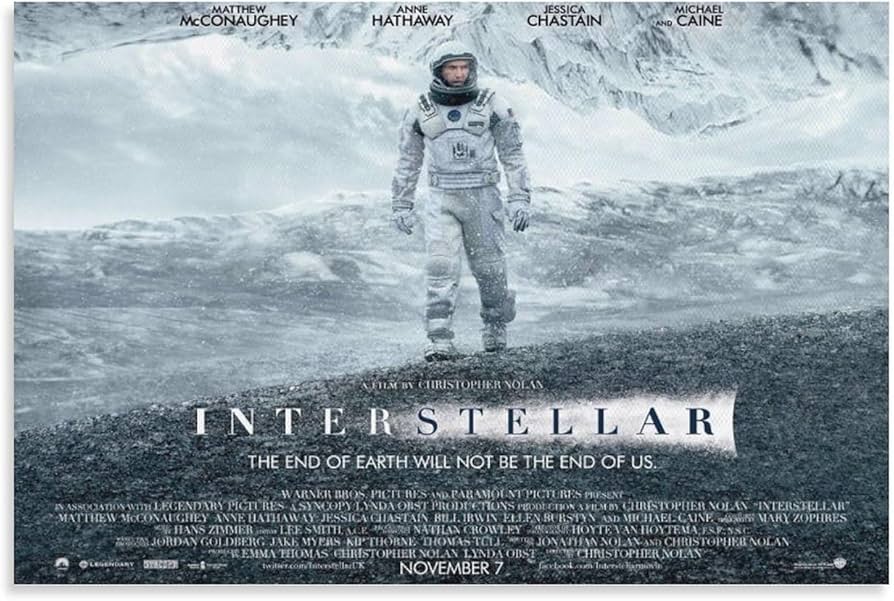INTERSTELLAR (2014)
- quoctinh
- November 3, 2024

Introduction to the Film
Interstellar is a science fiction film directed by Christopher Nolan, released in 2014. The film features renowned actors like Matthew McConaughey, Anne Hathaway, Jessica Chastain, and Michael Caine. It captivated audiences not only with its gripping storyline but also with its stunning visuals and meticulously researched astrophysics theories. As a result, Interstellar has become one of the most celebrated films exploring space travel and humanity’s future.
Brief Synopsis
The movie is set in a near-future Earth on the brink of collapse due to climate change and a severe depletion of natural resources. Humanity faces widespread famine, dust storms, and the disappearance of essential crops. Amidst these challenges, a group of scientists and astronauts embarks on a last-ditch mission to find a new habitable planet for humanity by traveling through a mysterious wormhole near Saturn.
The story follows Cooper (Matthew McConaughey), a former NASA pilot turned farmer, who is reluctantly drawn back into his previous life when he is recruited for this mission. Leaving behind his two children, especially his young daughter Murph (Mackenzie Foy and Jessica Chastain as an adult), Cooper joins the team, setting out to explore uncharted galaxies and potential planets for human survival. Throughout the journey, they encounter incredible cosmic phenomena, such as time dilation near black holes, which leads to Cooper experiencing time at a vastly different rate from his daughter back on Earth.

Themes and Concepts
Interstellar stands out for its exploration of profound themes like the bond between parents and children, sacrifice, and the indomitable will to survive. One of the film’s most unique aspects is its presentation of time dilation – a concept in physics that explains how time moves slower for objects in strong gravitational fields compared to those in weaker fields. This theory plays a central role in the emotional weight of the film, as Cooper’s mission to save humanity leads to heartbreaking time-related consequences in his relationship with Murph.
The movie also delves into scientific concepts like wormholes, black holes, and the fifth dimension, making the narrative both intellectually stimulating and visually awe-inspiring. Renowned physicist Kip Thorne served as a scientific consultant for the film, ensuring the depictions of black holes and other astrophysical phenomena were grounded in scientific reality. The black hole in Interstellar, named “Gargantua,” is one of the most accurate visualizations of a black hole in film, contributing significantly to the film’s critical acclaim.
Visual and Audio Achievements
The film’s breathtaking visuals, achieved through a combination of practical effects and CGI, elevate the cinematic experience. Hoyte van Hoytema’s cinematography captures the beauty and terror of space with sweeping shots and meticulously crafted visuals. Composer Hans Zimmer’s score, with its haunting and powerful organ compositions, also plays a key role in conveying the emotional depth and scale of the film. Zimmer’s music, which oscillates between quiet introspection and intense crescendos, adds a profound sense of wonder to the story.
Critical and Public Reception
Upon release, Interstellar received widespread praise for its ambition, visual effects, and emotional resonance. It grossed over $677 million worldwide, becoming one of the highest-grossing films of 2014. Critics highlighted Nolan’s ability to balance complex scientific concepts with a compelling emotional narrative, making it accessible to a broad audience. The film received numerous accolades and awards, including an Academy Award for Best Visual Effects, and remains a subject of discussion for its portrayal of scientific theories.
Legacy and Cultural Impact
Over time, Interstellar has cemented its place as a landmark in science fiction cinema. It has inspired discussions on time, space, and the potential for human life beyond Earth. Many consider it not only a cinematic achievement but also an artistic exploration of human nature, love, and the quest for survival.
In essence, Interstellar is a cinematic journey that transcends traditional storytelling, immersing audiences in a visionary experience that continues to captivate, challenge, and inspire.











